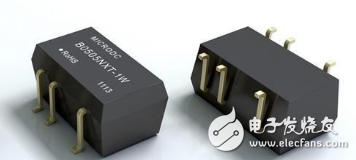
Privacy statement: Your privacy is very important to Us. Our company promises not to disclose your personal information to any external company with out your explicit permission.
Select Language
The difference between the isolation and non-isolation is mainly that the isolation regulator input circuit and the output circuit are not common, and the non-isolated is common ground.
In general, non-isolated inductor windings have primary and secondary sides, while isolated only has a single inductor. Use the isolated type when the high power and ground line interference protection requirements are relatively high, and use the non-isolated type in the case of relatively simple and relatively tight volume requirements. If the linear power supply is a linear adjustment output module (LDO), then the linear module must be non-isolated, so whether the power supply chip is an isolation regulator has nothing to do with the linear power supply and the switching power supply. Both isolation and non-isolation are the two major categories of switching power supply. The difference between isolation and non-isolation is that the isolation regulator input circuit and output circuit are not common, and the non-isolated is common ground. In general, non-isolated inductor windings have primary and secondary sides, while isolated only has a single inductor. Use the isolated type when the high power and ground line interference protection requirements are relatively high, and use the non-isolated type in the case of relatively simple and relatively tight volume requirements. If the linear power supply is a linear adjustment output module (LDO), then the linear module must be non-isolated, so whether the power supply chip is an isolation regulator has nothing to do with the linear power supply and the switching power supply. Both isolated and non-isolated are two large categories of switching power supplies. The following information can be used for your reference, and you will understand the difference between power module isolation and non-isolation.
When you choose isolated and non-isolated power modules, you need to have a clear understanding of your power requirements and reliability. The isolation module has high reliability, but the cost is high and the efficiency is poor. The non-isolated module has a simple structure, low cost, high efficiency, and poor safety performance. The serial communication bus transmits data over physical networks such as RS-232, RS-485, and Controller Area Network (CAN). Applications include industrial process control, power supply regulation (regulation), and point-to-point communication between computers. These interconnected systems are each equipped with their own power supply, and the systems are often spaced far apart. Because of this, we usually need to take electrical isolation measures to ensure the physical security of the system, and need to cut off the ground loop to protect the system from transient high voltage shocks while reducing signal distortion. Isolation protects the system from high voltages and large currents caused by line surges or ground loops, which is most likely to occur in systems that contain multiple ground paths. Each system is separated by long cables, and their ground potentials may not be equal, so ground currents are generated between the two systems. If no isolation is taken, this current will introduce noise into the system, reduce measurement accuracy and even destroy system components.
In industrial environments, motor start-up and shutdown, electrostatic discharge, or close-range lightning strikes couple current through inductive coupling into long-distance cables, causing rapid changes in ground potential, often up to hundreds or even thousands of volts. When such a phenomenon occurs, the logic level switching signal that the remote system expects to obtain is superimposed on a high voltage referenced to its local ground potential. If no isolation measures are taken, this voltage will destroy the signal and even damage the system. If all devices connected to the bus refer to the same ground, the system will be immune to this destructive energy, and isolation of the device will prevent ground loops and surges.
The CAN bus uses a balanced two-wire differential interface with a typical operating voltage of 3V or 5V. In some industrial control applications, due to the complex field conditions, there is a high common-mode voltage between the various nodes. Although the CAN bus has a certain ability to resist common mode interference, when the common mode voltage is higher than the limit voltage of the receiver, the receiver can no longer work normally, and even severely burns the chip and equipment. In order to achieve complete isolation between systems, all signal lines and power supplies must be isolated. Isolated signals are isolated by optocouplers, and isolated DC/DC converters provide power isolation.

November 25, 2022
November 25, 2022
Contactar proveedor
November 25, 2022
November 25, 2022
January 04, 2023
December 03, 2022

Privacy statement: Your privacy is very important to Us. Our company promises not to disclose your personal information to any external company with out your explicit permission.

Fill in more information so that we can get in touch with you faster
Privacy statement: Your privacy is very important to Us. Our company promises not to disclose your personal information to any external company with out your explicit permission.